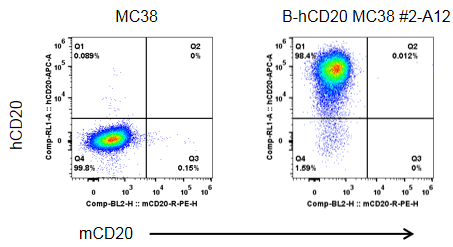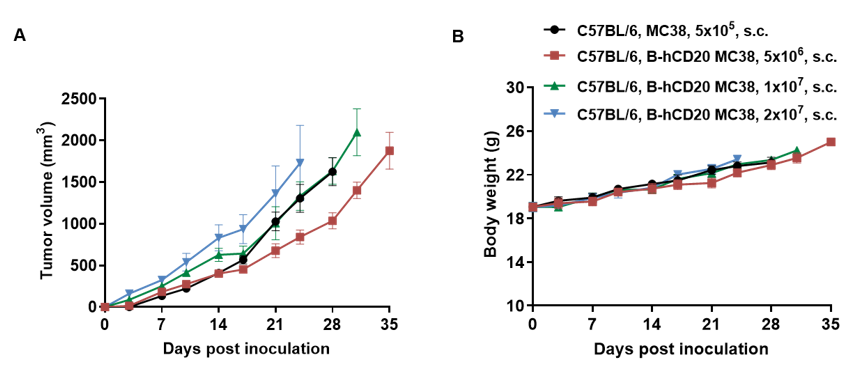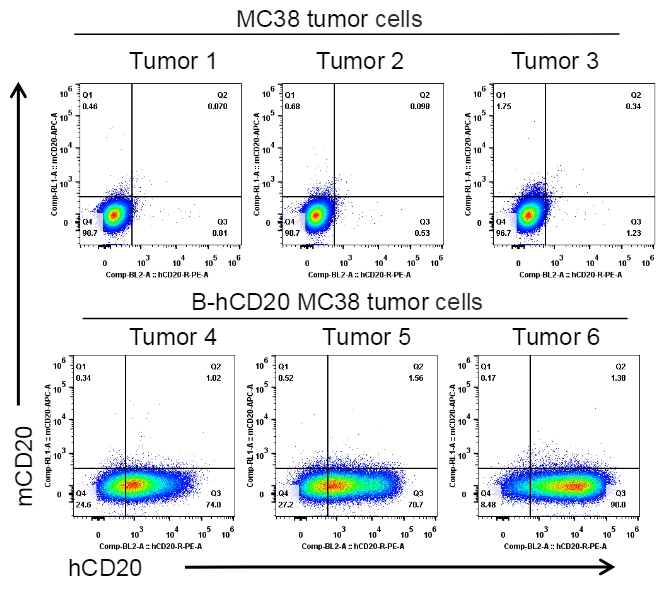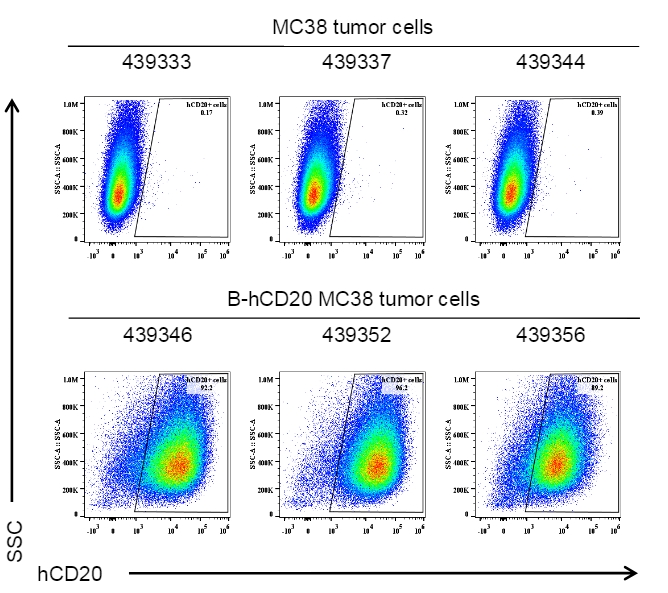


• 310716

| Product name | B-hCD20 MC38 |
|---|---|
| Catalog number | 310716 |
| Strain background | C57BL/6 |
| Aliases | MS4A1, Bp35, CVID5 |
| Tissue | Colon |
| Disease | Colon carcinoma |
| Species | Mouse |
| Application | B-hCD20 MC38 cells have the capability to establish tumors in vivo and can be used for efficacy studies. |
on this page
The human CD20 coding sequence was inserted into the ROSA26 locus in MC38 cells. Human CD20 is highly expressed on the surface of B-hCD20 MC38 cells.
Gene targeting strategy for B-hCD20 MC38 cells. The exogenous promoter and human CD20 coding sequence were inserted into the ROSA26 locus in murine.

CD20 expression analysis in B-hCD20 MC38 cells by flow cytometry. Single cell suspensions from wild-type MC38 and B-hCD20 MC38 cultures were stained with species-specific anti-CD20 antibody. Human CD20 was detected on the surface of B-hCD20 MC38 cells but not wild-type MC38 cells. The 2-A12 clone of B-hCD20 MC38 cells was used for in vivo experiments.

Subcutaneous homograft tumor growth of B-hCD20 MC38 cells. B-hCD20 MC38 cells and wild-type MC38 cells were subcutaneously implanted into C57BL/6 mice (female, 8-week-old, n=5). Tumor volume and body weight were measured twice a week. (A) Average tumor volume ± SEM. (B) Body weight (Mean± SEM). Volume was expressed in mm3 using the formula: V=0.5 × long diameter × short diameter2. As shown in panel A, B-hCD20 MC38 cells were able to establish tumors in vivo and can be used for efficacy studies.
The subcutaneous tumor formation of B-hCD20 MC38 cells was slow, and the inoculation dose was recommended to be increased to 1x107.

B-hCD20 MC38 cells were subcutaneously transplanted into C57BL/6 mice (n=5). At the end of the experiment, tumor cells were harvested and assessed for human CD20 expression by flow cytometry. As shown, human CD20 was expressed on the surface of tumor cells. Therefore, B-hCD20 MC38 cells can be used for in vivo efficacy studies of novel CD20 therapeutics.

Subcutaneous tumor growth of B-hCD20 MC38 cells.
B-hCD20 MC38 cells (5x106) and wild-type MC38 cells (5x105) were subcutaneously implanted into B-hCD3E mice (female, 6-8-week-old, n=6). Tumor volume and body weight were measured twice a week. (A) Average tumor volume. (B) Body weight. Volume was expressed in mm3 using the formula: V=0.5 × long diameter × short diameter2. Results indicate that B-hCD20 MC38 cells were able to establish tumors in vivo and can be used for efficacy studies. Values are expressed as mean ± SEM.

CD20 expression evaluated on B-hCD20 MC38 tumor cells by flow cytometry.
B-hCD20 MC38 cells were subcutaneously transplanted into B-hCD3E mice (n=6). Upon conclusion of the experiment, tumor cells were harvested and assessed for human CD20 expression by flow cytometry. As shown, human CD20 was highly expressed on the surface of tumor cells. Therefore, B-hCD20 MC38 cells can be used for in vivo efficacy studies evaluating novel CD20 therapeutics.